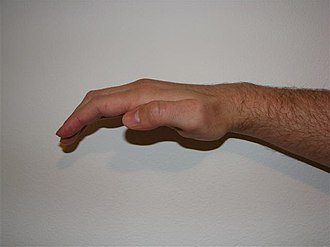Ape hand deformity
Editor-In-Chief: Prab R Tumpati, MD
Obesity, Sleep & Internal medicine
Founder, WikiMD Wellnesspedia &
W8MD medical weight loss NYC and sleep center NYC
| Ape hand deformity | |
|---|---|

| |
| Synonyms | Simian hand |
| Pronounce | N/A |
| Specialty | Neurology, Orthopedics |
| Symptoms | Inability to oppose the thumb, flattening of the thenar eminence |
| Complications | N/A |
| Onset | N/A |
| Duration | N/A |
| Types | N/A |
| Causes | Median nerve injury |
| Risks | Carpal tunnel syndrome, trauma |
| Diagnosis | Physical examination, Electromyography |
| Differential diagnosis | N/A |
| Prevention | N/A |
| Treatment | Surgery, physical therapy |
| Medication | N/A |
| Prognosis | Varies depending on cause and treatment |
| Frequency | Rare |
| Deaths | N/A |
Ape hand deformity is a condition characterized by the inability to oppose the thumb to the other fingers, resulting in a hand posture that resembles that of an ape. This condition is primarily associated with median nerve dysfunction, which affects the thenar eminence muscles responsible for thumb opposition.
Causes
Ape hand deformity is most commonly caused by injury or compression of the median nerve. This can occur due to:
- Carpal tunnel syndrome
- Trauma to the wrist or forearm
- Peripheral neuropathy
- Brachial plexus injury
- Tumors or cysts compressing the nerve
Pathophysiology
The median nerve innervates the thenar muscles, including the opponens pollicis, abductor pollicis brevis, and flexor pollicis brevis. These muscles are responsible for the opposition and flexion of the thumb. When the median nerve is compromised, these muscles become weak or paralyzed, leading to the characteristic posture of the thumb in ape hand deformity.
Clinical Presentation
Patients with ape hand deformity typically present with:
- Inability to oppose the thumb
- Flattening of the thenar eminence
- Weakness in thumb flexion and abduction
- Sensory loss in the lateral three and a half fingers
Diagnosis
Diagnosis of ape hand deformity involves:
- Clinical examination to assess thumb opposition and thenar muscle function
- Electromyography (EMG) and nerve conduction studies to evaluate median nerve function
- Imaging studies such as MRI or ultrasound to identify structural causes of nerve compression
Treatment
Treatment of ape hand deformity depends on the underlying cause and may include:
- Physical therapy to strengthen hand muscles and improve function
- Splinting to support the thumb and improve hand posture
- Surgical intervention to relieve nerve compression or repair nerve damage
- Occupational therapy to assist with adaptive techniques for daily activities
Prognosis
The prognosis for ape hand deformity varies depending on the cause and severity of the nerve injury. Early diagnosis and treatment can improve outcomes, but severe or prolonged nerve damage may result in permanent dysfunction.
See Also
Transform your life with W8MD's budget GLP-1 injections from $125.
W8MD offers a medical weight loss program to lose weight in Philadelphia. Our physician-supervised medical weight loss provides:
- Most insurances accepted or discounted self-pay rates. We will obtain insurance prior authorizations if needed.
- Generic GLP1 weight loss injections from $125 for the starting dose.
- Also offer prescription weight loss medications including Phentermine, Qsymia, Diethylpropion, Contrave etc.
NYC weight loss doctor appointments
Start your NYC weight loss journey today at our NYC medical weight loss and Philadelphia medical weight loss clinics.
- Call 718-946-5500 to lose weight in NYC or for medical weight loss in Philadelphia 215-676-2334.
- Tags:NYC medical weight loss, Philadelphia lose weight Zepbound NYC, Budget GLP1 weight loss injections, Wegovy Philadelphia, Wegovy NYC, Philadelphia medical weight loss, Brookly weight loss and Wegovy NYC
|
WikiMD's Wellness Encyclopedia |
| Let Food Be Thy Medicine Medicine Thy Food - Hippocrates |
Medical Disclaimer: WikiMD is not a substitute for professional medical advice. The information on WikiMD is provided as an information resource only, may be incorrect, outdated or misleading, and is not to be used or relied on for any diagnostic or treatment purposes. Please consult your health care provider before making any healthcare decisions or for guidance about a specific medical condition. WikiMD expressly disclaims responsibility, and shall have no liability, for any damages, loss, injury, or liability whatsoever suffered as a result of your reliance on the information contained in this site. By visiting this site you agree to the foregoing terms and conditions, which may from time to time be changed or supplemented by WikiMD. If you do not agree to the foregoing terms and conditions, you should not enter or use this site. See full disclaimer.
Credits:Most images are courtesy of Wikimedia commons, and templates, categories Wikipedia, licensed under CC BY SA or similar.
Contributors: Prab R. Tumpati, MD



